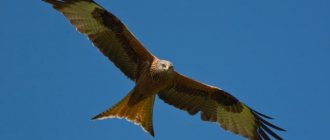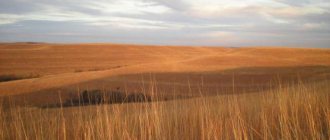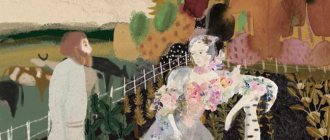4.1
Average rating: 4.1
Total ratings received: 86.
4.1
Average rating: 4.1
Total ratings received: 86.
“Leaves” is an example of F. I. Tyutchev’s early work. In this work, the author intertwined fairy-tale, landscape and philosophical motifs. A forest is depicted here, a parallel is drawn between processes in nature and human life. They study poetry in 6th grade. We suggest making your preparation for the lesson easier by using a brief analysis of “Leaves” according to the plan.
The material was prepared jointly with a teacher of the highest category, Kuchmina Nadezhda Vladimirovna.
Experience as a teacher of Russian language and literature - 27 years.
Brief Analysis
Before reading this analysis, we recommend that you familiarize yourself with the poem Leaves.
History of creation - the work was written in 1830, when the poet was serving in Germany. “Leaves” was first published in 1879 in the Russian Archive magazine.
The theme of the poem is the theme of freedom, the contrast of cold calm with rebellious nature.
Composition – The poem is written in the form of a monologue of leaves. In its meaning, several parts can be distinguished: reflections of the leaves on the needles, comparison of the “skinny greenery” with its beauty and the decision to fly away with the wind. The work consists of four octaves.
Genre : lyric poem.
The meter of the verse is two-foot amphibrachium, the rhyme pattern is cross ABAB.
Metaphors - “pine trees and spruces... wrapped in snow and blizzards, they sleep,” “we are an easy tribe,” “we visit on the branches for a short time,” “the marshmallows have left.”
Epithets – “skinny greenery”, “red summer”, “bothersome branches”, “violent winds”.
Comparisons - “green, like hedgehog needles.”
Analysis of F. I. Tyutchev’s poem “Leaves”
F.I. Tyutchev is an unsurpassed master of landscape poetry. His lines about nature rarely tell only about weather phenomena. There is always a philosophical subtext. The poet's life was filled with love, vivid experiences, but not always positive.
Fyodor Ivanovich is a man with a difficult fate. He spent half his life away from his homeland, which he loved very much. And I missed the Russian expanses. Therefore, in every landscape poem there is an undisguised melancholy. But the most poignant lines were born in autumn.
Tyutchev's early poetry was archaic, reminiscent of the poems of the last century. The writing style was similar to the sublime lyrics of the idols of youth: Zhukovsky, Dmitriev, Derzhavin.
The poem “Leaves” was written in 1830, when Fyodor Ivanovich’s own, unique style began to appear in the lyrics. This was a relatively calm period of his life. Munich gave the young man the whole range of love experiences. And in 1830, the marriage with Eleanor Petterson was finally formalized. Anxieties and doubts are left behind. And the misfortune that will destroy family happiness is not even on the horizon.
The work will not be published until 1879. This work takes its rightful place both in the poet’s landscape and philosophical lyrics. In the description of nature, the philosophical subtext is quite clearly visible.
The poem is based on personifications. The structure of the work is peculiar. In essence, this is a monologue, a song of autumn leaves that strive to fly. The entire story is told on their behalf. They take the place of the lyrical hero and narrator. The author and the reader become outside observers of what is happening.
Leaves think, feel, live. They express the author’s thoughts about his own life. This is a striking example of artistic parallelism in Russian poetry. When the lyrical hero is equated with the forces of nature. And his moods are expressed by weather phenomena.
The poem belongs to the romantic style and consists of four stanzas, each with eight lines. The first quatrain describes a winter forest, a kind of work for the future. There is no pretty description of snow-capped trees here. The author talks about the eternal greenery of pines and spruces. They do not lose their color all year round, but the needles are not fresh. It is contrasted with a description of bright autumn leaves that are destined to fly around. The leaves are happy with their fate.
The author's idea is clear that it is better to live briefly, but brightly, and not bow to anyone. Instead of groveling all your life, drowning in dullness, boredom, ordinariness. The boring monotony of the existence of “skinny greens” is unattractive. The needles of coniferous trees are a symbol of people who do not know how to live brightly, freely, and openly express their opinions. And again there is a parallel between natural phenomena and human life.
The poem is built on contrast. The “light tribe” of leaves does not live long. Only one summer “stays on the branches.” A reminder that “we are all guests in this world.” But he spends the allotted time cheerfully, carefree, brightly, richly. They are born in early spring. They bask in the sun in the summer, fed by warm rain, and then disappear from the branches in early autumn.
They will not see the dirt of late autumn, the first November frosts and severe winter. An ideal life, according to the author. Tyutchev at that time had already reached adulthood and started a family. He was caught up in everyday life. There is a longing for carefree youth, thoughts of inevitable old age.
In the last stanza the pace of the poem accelerates. The illusion of flight is created. The leaves are in a hurry, urging the wind to take them with it. Alliteration plays an important role in the perception of a poem. The same consonants are repeated, creating a special sound outline, giving expressiveness to the text.
Question to the expert
Googlemag
Ask! Do not be shy!
Ask a Question
History of creation
The analysis of the poem should begin with the history of its writing. In 1821, Fyodor Ivanovich went to serve in Germany. Being a diplomat, the poet did not forget about his talent for poetic art. Philosophical motives play an important role in his “Munich” works. Apparently, this is due to the fact that in Germany the poet met the philosopher Schelling, who defended the idea of the unity of opposites in nature. After 9 years of living abroad, Tyutchev created “Leaves” (1830), which reflected the idea of the German philosopher.
In 1879, the poem was published on the pages of the Russian Conversation magazine. To this day, it is considered one of the best examples of landscape and philosophical lyrics in Russian literature.
Subject
Nature repeatedly inspired Tyutchev on philosophical quests. In the analyzed poem, the author developed two themes at once: the theme of freedom and the contrast of cold calm with rebellious nature. To reveal the soul of nature, the poet used personification, humanizing the leaves. The lyrical hero of the work practically does not show himself; he merges with the image of the leaves, because he completely shares their views.
In the first two stanzas of the poem, the leaves say that they consider themselves more beautiful than the pine needles. The “skinny green” of fir trees, in their opinion, never looks alive. The leaves cannot understand how you can sleep through the entire winter, wrapped up in a snowstorm. The “light tribe” openly admires itself: “we... bloom and shine.” The leaves remember how in summer they played with the sun and bathed in dew.
The cheerful mood of the green company fades when it realizes that autumn is on the doorstep. The leaves look around and see that everything around has faded, turned pale, and the birds have fallen silent. The “easy tribe” does not want to turn yellow, so they decide to fly away with the wind. Now the branches seem “bothering” to the leaves, so they try to fly away as quickly as possible.
In the image of leaves you can see human nature. They symbolize people who cannot sit in one place while waiting for old age. Such people strive for new achievements and freedom. The needles of the fir trees symbolize the opposite human character.
The main idea is figuratively expressed in the lines: “so why should we hang and turn yellow for nothing?”
Images and symbols
The poem “Leaves” is interesting because the lyrical hero is presented in the form of one of many leaves. That is, he is one of many, of many “simple”, one of the “easy tribe”. He can be described as cheerful and adventurous.
The entire work is built on simple images. It can be assumed that pine needles are “conservative” people who live “as usual”, without the opportunity, or even the desire, to change anything, to take risks, without the desire to somehow “decorate” their lives, the lives of those around them. The poet writes that “their skinny greenery... never turns yellow, but is never fresh,” that is, they look the same as everyone else, but there is no vital spark in them, it is lost.
Leaves are another category of people who are not afraid of change, people who take risks, strive for the best, and seek adventure. The author calls such people a “tribe,” that is, an association that is not connected territorially, but is connected by tribal relations, in this case by ideological principles.
It is also interesting that the author recognizes the “fast” life of such characters, but he also writes that they “stay on the branches for a short time,” that is, some “leaves” will leave, but in their place others will certainly appear, just as bright , “alive”, trying to fly away.
“All the red summer we were in glory”
“Red” and “beautiful” are words with a general meaning. The symbolism of this color is diverse, but positive on all sides. Red is a symbol of power and wisdom, a symbol of love, a symbol of beauty, a symbol of fire, a symbol of joy and fullness of life. The chosen metaphors are not accidental; it can be assumed that these lines indicate that “larch” people are on the “front line” of life, such people are aware of all the events taking place, they are full of life.
“But the birds died away, the flowers faded, the rays turned pale, the zephyrs left.”
These lines can be translated as a change in a suitable, “militant” situation, or a change in one’s own point of view. After such changes, the thought comes to the minds of the “adventurous” leaves:
“So why should we hang and turn yellow for nothing? Wouldn’t it be better to follow them and fly away!”
That is, a change in the environment, a change in the foundations, requires a change of “leaves”, requires new views, new daredevils who will certainly appear in the vacant places.
“O wild winds, Hurry, hurry! Hurry up and pluck us from the annoying branches!”
Wind is a symbol of time, speed and space, as well as rebirth. It is not without reason that the lyrical hero in Tyutchev’s work asks the wind to “pluck” him from the boring “branches”. This stanza, these lines convey the lyrical hero’s readiness for self-sacrifice for the sake of better changes, for the sake of speedy changes, for the sake of a bright future.
Means of expression
For an original interpretation of the philosophical theme, Fyodor Ivanovich used various means of expression. With their help, images of nature are created and the feelings and emotions of the lyrical hero are reproduced.
Metaphors predominate in the poem : “pines and spruces... wrapped in snow and blizzards, they sleep,” “we are an easy tribe,” “we visit for a short time on the branches,” “the marshmallows are gone.” The finishing touches are “applied” with the help of epithets : “skinny greenery”, “red summer”, “bothersome branches”, “violent winds”. Simile : “green, like hedgehog needles.”
In some lines alliteration role, for example, the sadness of the leaves is emphasized with the help of the consonants “s”, “zh” (“so why should we hang and turn yellow for nothing?”), and their determination is conveyed by stringing words with the consonant “r” (“ Hurry, hurry!, Hurry, tear us down...").
Composition
The poem “Leaves” contains 4 stanzas of 8 lines, that is, 4 octaves. The work is structured in the form of a monologue of the lyrical hero. The composition is consistent. The poem can be divided into 4 plot parts corresponding to stanzas.
- Part 1 – 1st eight-verse. The poet writes about coniferous trees, about pines and spruces, which always stand “dressed” and green. The author recognizes their uniqueness, but in describing them he uses “simple” vocabulary, that is, he does not select “beautiful” words, but writes a little mediocre, using words such as “stick out,” “sleep,” “skinny green,” “hedgehog needles.” , “not fresh.” This speaks, on the one hand, of the author’s appreciation for the peculiarity of such trees, and on the other hand, of the ordinariness of this.
- Part 2 – 2nd eight-verse. Here the poet writes about the “light tribe,” that is, about ordinary leaves, whose life is limited, but at the same time “varied.” This stanza shows a little more authorial sympathy. “Light tribe”, “bloom and shine”, “short time”, “guest”, “beautiful”, “bathed in dew” - these words and phrases are pleasant to the ear, they are more “careful” and “sensitive”.
- Part 3 – 3rd stanza. This part talks about the inevitable fall of leaves. Perhaps someone will perceive this with sadness, but the poet describes it joyfully and with a bit of hope.
“...The Zephyrs are gone. So why should we hang and turn yellow for nothing? Wouldn’t it be better to follow them and fly away!”
That is, flying away is the best, “most beautiful” option, which only the “light tribe”, the leaves, can choose.
- Part 4 is the last stanza, which is filled with determination, courage, hope, even self-sacrifice.
“O wild winds, Hurry, hurry! Hurry up and pluck us from the annoying branches!”
This part begins with the interjection “o”, which adds even more emotionality and impetuosity to the last eight-line.




